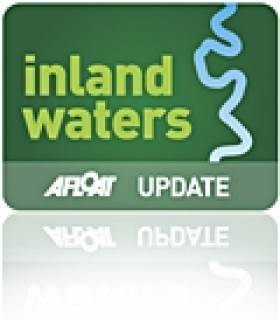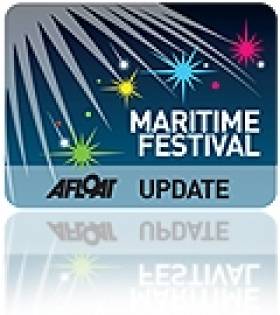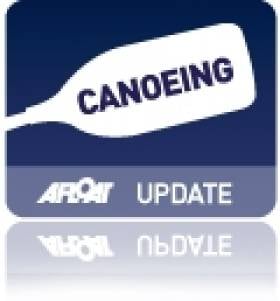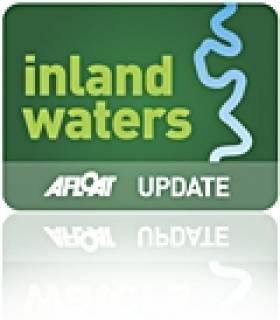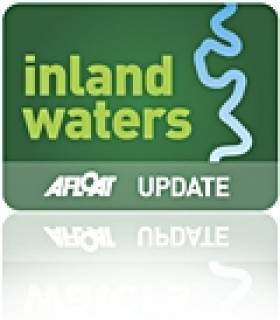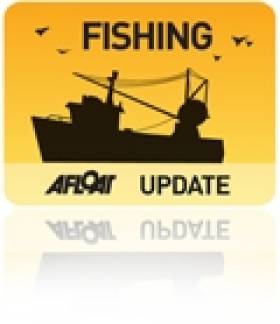Displaying items by tag: River Shannon
Waterways Ireland TriAthlone Launches With A Splash
#TriAthlone - This Saturday 5 July sees the return of Ireland's original town-centre triathlon, the Waterways Ireland TriAthlone, for its ninth edition on the River Shannon.
Yesterday the local organising committee were joined by Triathlon Ireland vice-president Tony Daley and Charles Lawn, inspector of navigation with Waterways Ireland, to launch this year's event, which will see the return of the Vodafone Triathlon Ireland Sprint Series, alongside the Paratriathlon National Championship, which has found its home in Athlone since the hosting of a record-breaking European Championships in 2010.
As for the main event, 2013 Athlone European Junior Cup Champion and former World Junior Championships Bronze medalist Con Doherty leads the field and is favourite to be crowned champion this year, but certainly not without a challenge.
The day promises an exciting spectacle, with the genuine stars of the future battling it out in the River Shannon and on the streets of the Midlands town for national honours.
With almost every county in Ireland represented and up to 15,000 spectators expected to line the streets, Athlone is gearing up for yet another great triathlon.
And this year spectators can track triathletes as they make their way around the course via a free app for smartphones. Details of how to get the app are available at www.triathlone.com.
The Waterways Ireland TriAthlone begins with a swim in the River Shannon, from which the competitors will then take to their bikes for a cycle through South Co Roscommon before the exciting towncentre run which will see the event finish in the heart of Athlone.
Speaking about the event, chairman Liam Heavin said: "2014 promises to be another very exciting year in Athlone, and it's a privilege for us to host the top national athletes as part of the Vodafone National Series. This has been a team effort and couldn't be achieved without the support of Waterways Ireland and Westmeath County Council.
"We would like to encourage as many people as possible to come along and support the event this weekend!"
#shannon – A new festival named in honour of a Limerick man who famously completed a solo circumnavigation of the world will take place along the banks of the River Shannon in Limerick City on Sunday June 8th next.
Organised and funded by the Mid West Regional Authority (MWRA) through its participation in a European Programme for developing and promoting the watersports sector in Europe's Atlantic Area, the 'Pat Lawless Sail and Oar Festival' will celebrate Limerick's status as a riverside city and will feature a series of events on the river.
For spectators gathered on either side of the river at Harvey's Quay and Clancy Strand, there will be Rowing and Sailing Regattas, a historic kayak tour of Limerick City and a Gandelow boat demonstration.
The late Pat Lawless made international headlines in 1996 when the then 70-year-old sailed his 30-foot vessel, the Seadog, up the Shannon Estuary on the final leg of his 30,000-mile around the world voyage. Mr. Lawless, who was from the South Circular Road and was a member of the Iniscealtra Sailing Club in Mountshannon, passed away in 2010.
Majella O'Brien, EU Projects Officer with the MWRA explained that the upcoming festival is part of its ongoing efforts through the NEA2 project to develop and promote the watersports sector in the Mid West Region.
"Lough Derg, the River Shannon and the Estuary are intrinsically linked with the economic and social history of this region. The potential of these waterways for tourism development remains underexplored however. By hosting the 'Pat Lawless Sail and Oar Festival" we want to demonstrate this potential to our European project partners," she said.
Ms. O'Brien continued: "Through our participation in the NEA2 programme and by working in conjunction with other regional development agencies, the MWRA will continue to look for new ways that this region can build on existing marine leisure initiatives to help inform and develop new opportunities for sustainable development of water sports on our rivers, lakes and coastline. In doing so, we could attract thousands of additional visitors to the Mid West Region each year."
"We are particularly delighted to be able to host a river festival in honour of Pat Lawless whose crossings of the Atlantic Ocean and solo circumnavigation of the world brought great pride to Limerick and the wider region," she concluded.
The 'Pat Lawless Sail and Oar Festival' takes place in Limerick City on Sunday June 8th next.
Body Recovered From Shannon Feared To Be Missing Limerick Teen
#News - A body has been recovered by divers from the River Shannon in Limerick city today (4 October), as RTÉ News reports.
Divers with Limerick Search and Rescue had been taking part in the major search operation for missing teenager Chloe Kinsella when they made the grim discovery before noon near Thomond Bridge in the city.
Though the body has yet to be formally identified, it is feared to be the 15-year-old who went missing from her home in the city last Saturday 28 September.
Man Drowns In Shannon At Athlone
#Drowning - The Irish Times reports that the body of a man who fell into the River Shannon while on a night out in Athlone has been recovered.
The victim, in his 50s, was with friends when he apparently slipped off the wall of Town Bridge late last night (7 September). A postmortem is due and Gardaí are investigating the incident.
Canoeing Students Paddle The Shannon For Charity
#Canoeing - The Longford Leader reports on a recent canoeing adventure by four college students along the River Shannon to fundraise for the Irish Cancer Society.
The four set off from the Shannon Pot in Co Cavan, giving themselves 10 days to reach the Shannon Estuary at Limerick - more than 250km away.
And amazingly, they completed the challenge with two days to spare!
The Longford Leader has much more in the story HERE.
Big Decline In Shannon Passages Over Last 10 Years
#Shannon - Passages on the River Shannon in 2013 so far have fallen more than 50% compared to numbers for the same period a decade ago, according to the Irish Waterways History blog written by Afloat's inland correspondent, Brian Goggin.
Using statistics supplied by Waterways Ireland, the site plotted a graph that shows an overall decline in lock and bridge passages on the Shannon in the months from January to May each year since 2003, with a slight spike in 2007 the only buck in the downward trend.
Though the figures do not record all uses of the waterway (such as sailing, angling and other watersports) and do not account for variables such as the weather, they are indicative - the site claims - of "the Shannon's most significant tourism activity, the cruiser hire business".
Indeed, the figures apparently show that boat hire passage numbers have fallen from 11,440 in January-May 2003 to just 4,781 in the same months this year.
Even private boat passages have been falling from a peak in 2009 to just below their 2003 numbers, if the site's interpretation of the stats is anything to go by.
However, a source close to Afloat.ie says that the falling numbers may be skewed by a growing emphasis on larger-capacity vessels on Ireland's inland waterways, with eight- and 12-berth boats supplanting older four-berth vessels, and families and groups consolidating their recreational boating.
It will be interesting to see how the rest of the year turns out, and whether the overall numbers from January to December will tell a different story of the state of the Shannon and other waterways.
#InlandWaterways - Waterways Ireland has advised all masters and users of the Erne system that the channel east of Castle Island near Enniskillen will be closed till Tuesday 11 June to facilitate a number of events on the water.
Mariners are directed to follow the marked navigation channel and signs to the west of Castle Island and proceed at a slow speed and with minimum wash. They should note any advise or instructions given by event organisers when in this section of the navigation.
Public jetties in the vicinity will remain accessible throughout, though some minor restrictions may be in place as and when required. Further information is available from the Lough Erne warden at 028 6632 3004.
Elsewhere, there will also be restricted mooring for masters and owners on the River Shannon at Carrick-on-Shannon to facilitate spectator viewing of the Carrick 400 event.
On Sunday 2 June the quay wall from the downstream face of the town bridge to the floating moorings will be out of bounds for mooring from 7pm till midnight.
In other waterways news, recent water quality testing has shown the harbour at Kilcock on the Royal Canal to now be within normal bathing water standards.
New TV Series Unveils 'Secret Life of the Shannon'
#OnTV - Sunday 26 May sees the first of a two-part documentary series on The Secret Life of the Shannon on RTÉ One.
The series will take viewers on a journey along the River Shannon with wildlife cameraman and presenter Colin Stafford Johnson, who spent a year living on the river on a barge, camping on its banks and exploring its tributaries in a traditional canoe.
His quest was to film the natural history of the 340km of the Ireland's longest inland waterway as it has never been seen before - and if the above video is anything to go by, he's done an incredible job.
The Secret Life of the Shannon part of the RTÉ Goes Wild month-long celebration of Ireland's wildlife on television, radio and online.
Episode one will be broadcast on Sunday 26 May at 6.30pm on RTÉ One, with the second episode to follow at the same time on Sunday 2 June.
Dive Ireland 2013 Is 'Huge Success'
#Diving - The Irish Underwater Council (CFT) reports the "huge success" of the 22nd annual Dive Ireland expo in Athlone at the weekend.
The two-day event at the Hodson Bay Hotel welcomed "speakers from near and far as well as photography workshops and a fully loaded international trade fair" - not to mention the CFT National Dive Conference and AGM.
Ahead of the expo, Minister for Arts, Heritage and the Gaeltacht Jimmy Deenihan commented on the role of SCUBA clubs and diving centres in Ireland's national tourism infrastructure in promoting this country's dive sites.
In the foreword to the recently published Warships, U-boats and Liners, he also wrote of the Government's commitment to developing its archive of wrecks in Irish waters.
“With the support of responsible dive centres and local dive clubs ... these wrecks can be explored now and into the distant future by visitors from home and abroad.”
According to the CFT, local authorities are also starting to recognise the importance of developing aquatic activities to encourage tourism.
One example is Mayo County Council's Blue Ways list of swimming and snorkelling sites along the county's coast, which complements its Green Ways walking trails.
The council also highlighted the importance of heritage among Ireland's diving community, and their role in discoveries such as the Viking-era swords retrieved from the River Shannon near Banagher last autumn, as the Offaly Independent reports.
Eamon Cusack Is New Chair of Institute of Fisheries Management
#Fishing - One of Ireland’s most eminent fisheries experts and a recent CEO of the Shannon Regional Fisheries Board has been elected chairman of the Institute of Fisheries Management.
Eamon Cusack will assume the chair at the UK-based international body that promotes sustainable management of freshwater and marine fisheries.
Cusack said he was “passionate” about protecting and rebuilding fisheries threatened by habitat damage and over-exploitation.
To ensure their future, he would seek to continue to build successful partnerships between government and non-government organisations.
Cusack succeeds Ian Dolben, who served as chairman over the past five years. Dolben credited the success of the institute during his term to members taking on voluntary roles, changing its public face and taking its members’ services to a new level.
Eamon Cusack has over 35 years’ experience in the development and management of inland fisheries, including EU-funded projects, and has been an active member of the institute for more than 30 years.
He is currently chairman of the Shannon Fishery Partnership, which advises on the management of the ESB’s fisheries on the River Shannon, and a director of Recreational Angling Ireland.
He was a ministerial appointee to the Irish Central Fisheries Board, which oversees Irish national fisheries policy and strategy.
A native of Galway, Cusack grew up on the banks of the River Dodder in Dublin. While a young member of Dodder Anglers, the largest angling club in Ireland, he became aware of the many pressures facing fisheries which began his lifelong interest in their management.


























